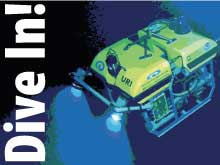
Bioprospecting for medicines from the deep sea.
Education Lesson Plans
During the Medicines from the Deep Sea expedition, scientists will use the NOAA Ship Ronald H. Brown and a remotely operated vehicle (ROV) to explore deep-water habitats in the Gulf of Mexico for novel bioactive compounds found in certain types of marine organisms. These organisms include sponges, cnidarians, mollusks, annelids, echinoderms, ascidians, and microorganisms, many of which have potential as pharmaceutical products or biomedical research tools. The results of studies on the bioactivity and chemistry of novel compounds isolated from the samples collected during this expedition may be applied in the long term to the development of compounds used to study, diagnose, and treat human diseases, including cancer, infectious diseases, diseases of the immune system, cardiovascular disease, and disorders of the central nervous system.
Educators and scientists working with NOAA during August 2003 developed a series of lesson plans for students in Grades 5-12 that are specifically tied to Medicines from the Deep Sea: Exploration of the Gulf of Mexico Expedition. These lesson plans focus on cutting-edge ocean exploration and research using state-of-the-art technologies. Lessons focus on benthic invertebrates that produce pharmacologically active substances, screening natural products for biological activity, bioassays, the function of cell organelles and the genetic code in chemical synthesis, bacterial endosymbionts and the organelles of eukaryotic cells, and the separation of complex mixtures.
The lesson plans are grouped into the following categories:
Grades 5-6
Grades 7-8
Grades 9-12 (chemical and biological science)
Each grade-level grouping includes activities that focus on the research being conducted as part of this expedition. In addition to being tied to the National Science Education Standards, the hands-on, inquiry-based activities include focus questions, background information for teachers, links to interesting Internet sites, and extensions. Web logs that document the latest discoveries and complement the lesson plans, complete with compelling images and video, will be sent back each day from sea. Teachers are encouraged to use the daily logs from the expedition to supplement the lesson plans.
Read a description of each lesson plan and/or download them
to your computer. All of the lesson plans are available in PDF format,
and may be viewed and printed with the free Adobe Acrobat Reader ![]() . To download a lesson plan, click on its title from
the listing below.
. To download a lesson plan, click on its title from
the listing below.
Grades 5-6
Chemists with no Backbones (4 pages, 356k)
Focus: Benthic invertebrates that produce pharmacologically active substances (life science)
In this activity, students will be able to identify at least three groups of benthic invertebrates that are known to produce pharmacologically active compounds and will describe why pharmacologically active compounds derived from benthic invertebrates may be important in treating human diseases. Students will also be able to infer why sessile marine invertebrates appear to be promising sources of new drugs.
Microfriends (6 pages, 420k)
Focus: Beneficial microorganisms (life science)
In this activity, students will be able to describe at least three ways in which microorganisms benefit people, describe aseptic procedures, and obtain and culture a bacterial sample on a nutrient medium.
Grades 7-8
Living by the Code (5 pages, 400k)
Focus: Functions of cell organelles and the genetic code in chemical synthesis (life science)
In this activity, students will be able to explain why new drugs are needed to treat cardiovascular disease, cancer, inflammation, and infections; infer why sessile marine invertebrates appear to be promising sources of new drugs; and explain the overall process through which cells manufacture chemicals. Students will also be able to explain why it may be important to sythesize new drugs, rather than relying on the natural production of drugs.
What Killed the Seeds? (5 pages, 415k)
Focus: Bioassays (life science)
In this activity, students will be able to explain and carry out a simple process for studying the biological effects of chemicals and will be able to infer why organisms such as sessile marine invertebrates appear to be promising sources of new drugs.
Grades 9-12
Cell Mates (6 pages, 444k)
Focus: Bacterial endosymbionts and organelles of eukaryotic cells (life science)
In this activity, students will be able to compare and contrast prokaryotic and eukaryotic cells, explain the endosymbiont theory for the origin of eukaryotic cell organelles, and explain evidence that suggests an endosymbiotic origin for at least two common eukaryotic cell organelles.
The Benthic Drugstore (4 pages, 360k)
Focus: Pharmacologically active chemicals derived from marine invertebrates (life science)
In this activity, students will be able to identify at least three pharmacologically active chemicals derived from marine invertebrates, describe the disease-fighting action of at least three pharmacologically active chemicals derived from marine invertebrates, and infer why sessile marine invertebrates appear to be promising sources of new drugs.
The Electric Sieve (5 pages, 400k)
Focus: Separation of complex mixtures (chemistry)
In this activity, students will be able to explain and carry out a simple process for separating complex mixtures, and will be able to infer why organisms such as sessile marine invertebrates appear to be promising sources of new drugs.
Watch the Screen! (5 pages, 428k)
Focus: Screening natural products for biological activity (life science)
In this activity, students will be able to explain and carry out a simple process for screening natural products for biological activity, and will be able to infer why organisms such as sessile marine invertebrates appear to be promising sources of new drugs.
For More Information
Contact Paula Keener-Chavis,
Director, Education Programs
NOAA Office of Ocean Exploration
Other lesson plans developed for this Web site are available in the Education Section.





















